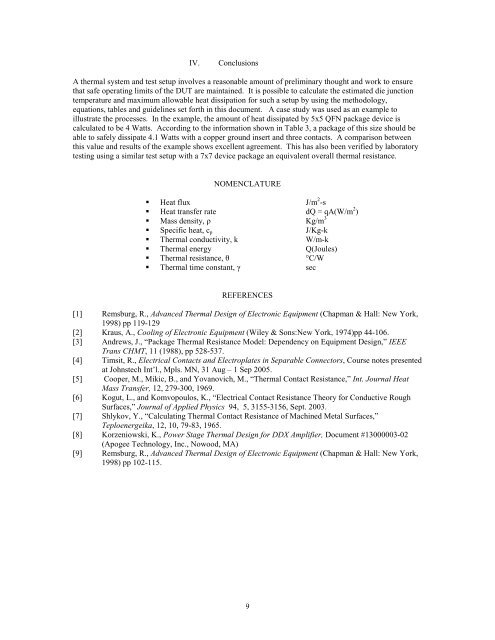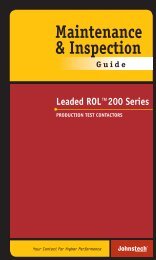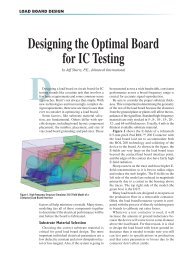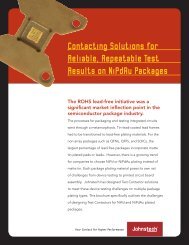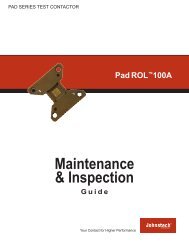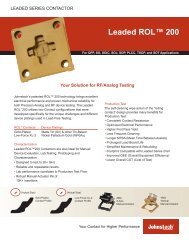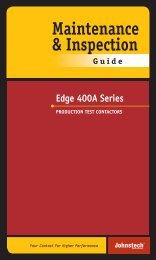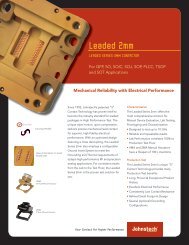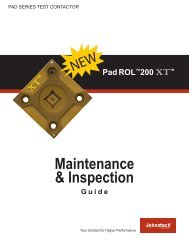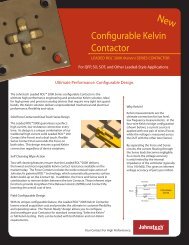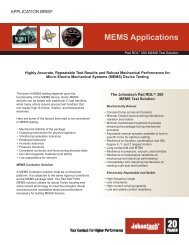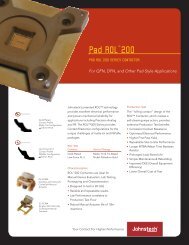Thermal Modeling and Analysis of Device-Contactor ... - Johnstech
Thermal Modeling and Analysis of Device-Contactor ... - Johnstech
Thermal Modeling and Analysis of Device-Contactor ... - Johnstech
You also want an ePaper? Increase the reach of your titles
YUMPU automatically turns print PDFs into web optimized ePapers that Google loves.
IV.ConclusionsA thermal system <strong>and</strong> test setup involves a reasonable amount <strong>of</strong> preliminary thought <strong>and</strong> work to ensurethat safe operating limits <strong>of</strong> the DUT are maintained. It is possible to calculate the estimated die junctiontemperature <strong>and</strong> maximum allowable heat dissipation for such a setup by using the methodology,equations, tables <strong>and</strong> guidelines set forth in this document. A case study was used as an example toillustrate the processes. In the example, the amount <strong>of</strong> heat dissipated by 5x5 QFN package device iscalculated to be 4 Watts. According to the information shown in Table 3, a package <strong>of</strong> this size should beable to safely dissipate 4.1 Watts with a copper ground insert <strong>and</strong> three contacts. A comparison betweenthis value <strong>and</strong> results <strong>of</strong> the example shows excellent agreement. This has also been verified by laboratorytesting using a similar test setup with a 7x7 device package an equivalent overall thermal resistance.NOMENCLATURE• Heat flux J/m 2 -s• Heat transfer rate dQ = qA(W/m 2 )• Mass density, ρ Kg/m 3• Specific heat, c p J/Kg-k• <strong>Thermal</strong> conductivity, k W/m-k• <strong>Thermal</strong> energy Q(Joules)• <strong>Thermal</strong> resistance, θ °C/W• <strong>Thermal</strong> time constant, γ secREFERENCES[1] Remsburg, R., Advanced <strong>Thermal</strong> Design <strong>of</strong> Electronic Equipment (Chapman & Hall: New York,1998) pp 119-129[2] Kraus, A., Cooling <strong>of</strong> Electronic Equipment (Wiley & Sons:New York, 1974)pp 44-106.[3] Andrews, J., “Package <strong>Thermal</strong> Resistance Model: Dependency on Equipment Design,” IEEETrans CHMT, 11 (1988), pp 528-537.[4] Timsit, R., Electrical Contacts <strong>and</strong> Electroplates in Separable Connectors, Course notes presentedat <strong>Johnstech</strong> Int’l., Mpls. MN, 31 Aug – 1 Sep 2005.[5] Cooper, M., Mikic, B., <strong>and</strong> Yovanovich, M., “<strong>Thermal</strong> Contact Resistance,” Int. Journal HeatMass Transfer, 12, 279-300, 1969.[6] Kogut, L., <strong>and</strong> Komvopoulos, K., “Electrical Contact Resistance Theory for Conductive RoughSurfaces,” Journal <strong>of</strong> Applied Physics 94, 5, 3155-3156, Sept. 2003.[7] Shlykov, Y., “Calculating <strong>Thermal</strong> Contact Resistance <strong>of</strong> Machined Metal Surfaces,”Teploenergeika, 12, 10, 79-83, 1965.[8] Korzeniowski, K., Power Stage <strong>Thermal</strong> Design for DDX Amplifier, Document #13000003-02(Apogee Technology, Inc., Nowood, MA)[9] Remsburg, R., Advanced <strong>Thermal</strong> Design <strong>of</strong> Electronic Equipment (Chapman & Hall: New York,1998) pp 102-115.9


